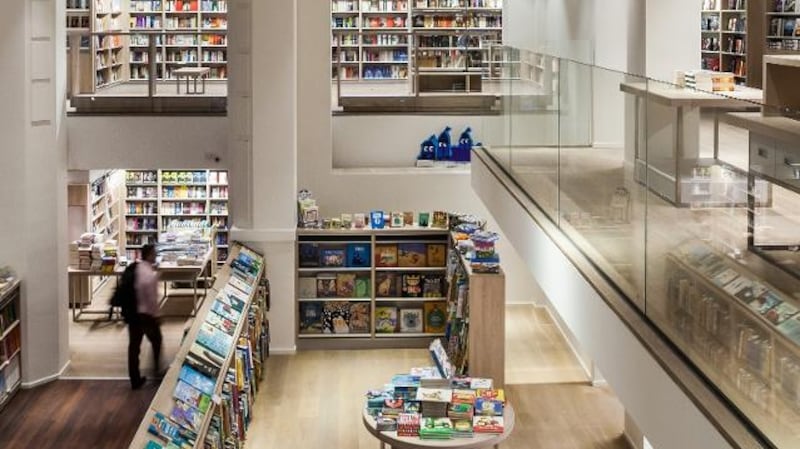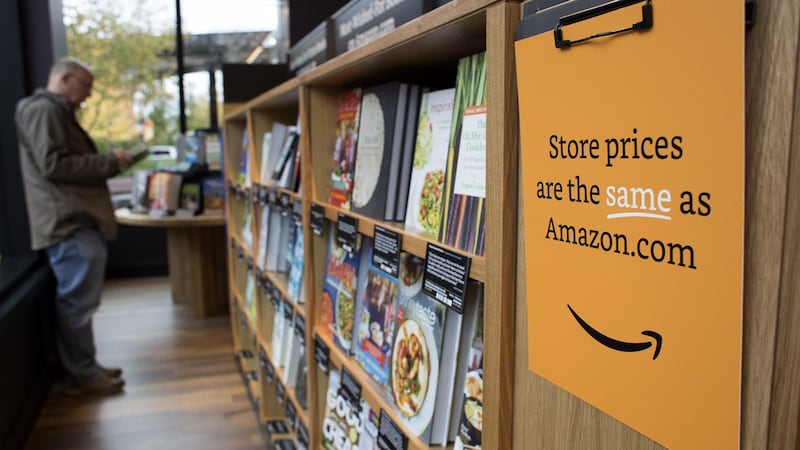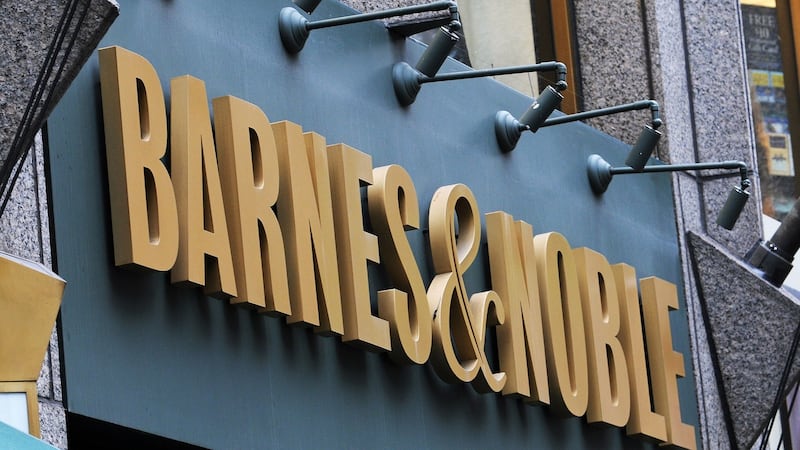To anyone who remembers the chaotic old Foyles bookstore in central London, its new incarnation a few doors further up Charing Cross Road is a remarkable sight.
Sleek in design, well-ordered in layout with enticing curated clusters of books recommended by staff, Foyles now comes with many of the familiar signature notes of contemporary high street retailing: the café, the gallery and events space, and the atrium, a central reference point for five floors devoted to the pleasure of reading, a mission underscored by the bold slogan stamped on one of the walls: “Welcome book lovers, you are among friends.”
Such engaging self-confidence is a refreshing, even defiant break from the gloom that has stalked bookselling – and publishing – in recent years. It is also in keeping with a new approach to bookselling by Waterstones, which bought Foyles last year.
Since almost going out of business nearly a decade ago Waterstones has reinvented itself under chief executive James Daunt, junking many of the customs of chain store retailing in a bid to prove that in a sector dominated by the disruptive might of US ecommerce group Amazon, there is still life and profit to be found in high street retailing.
Experience
Now the question is whether Mr Daunt can repeat the experience across the Atlantic. Last week Elliott Management, Waterstones’ owner, agreed to buy Barnes & Noble, the ailing national US bookstore chain, in a $683 million (€604 million ) deal that will see Mr Daunt move to New York to take charge of the American company and its 627 stores alongside his continuing stewardship of Waterstones.
The fact that Elliot, a wing of the activist hedge fund founded by Paul Singer, and a company known more for its forensic reading of balance sheets and appreciation of turnaround profits than its love of fine writing, has made two big investments in the sector within the space of a year has lifted spirits in an industry that until recently felt it was fighting for its very survival as Amazon rewrote the rules of the book business.
While booksellers were among the first retailers to feel the full force of the Amazon effect, with the Borders chain closing in 2011, the rest of the industry has begun to suffer. In the past two years, there have been a string of retail bankruptcies and mall closures as a result of the relentless rise of ecommerce. Yet the Barnes & Noble deal is the latest sign that the book trade, at least, may have seen Amazon reach the peak of its influence.

“There are limits to the online experience. In the world of books it is as good as it can be,” says Mr Daunt, a former banker who made his name running a boutique London bookshop chain. “Now other retailers are going through what we went through. We endured the fire and it forced us to dramatically improve our shops and raise our game.”
The two companies will be run as separate businesses and Mr Daunt says his aim is not to turn Barnes & Noble into Waterstones, but rather to create the conditions for it to be a better bookseller: “I won’t dictate,” he adds.
Costs
Still, he hopes to expand Barnes & Noble – “America is very under-bookshopped” – and expects to deploy some of the strategies that have served him well in the UK such as devolving power, particularly over purchasing, to local managers at Waterstones’ more than 280 shops. This contributes to more efficient management of stock, reducing the costs and hassle of handling unsold “returns” – books bulk ordered by head office with little regard for differences in regional reading habits. Indeed, one of the competitors the new Barnes & Noble will face is Amazon itself, which now has 19 bookshops across the US, with store managers benefiting from the data that Amazon collects on the market.
The empowering of store managers, making outlets appear distinctively individual rather than another piece of a centrally-directed operation, is also part of an emphasis on improving customer experience – one of the precious few advantages a bricks-and-mortar operator has over pure ecommerce rivals. “You want to enjoy yourself, to bring your kids and have fun buying a book,” says Mr Daunt. Get that right and customers will come, and spend.
Joseph Evans, senior research analyst at Enders, wonders – given the scale of Barnes & Noble, which has more and bigger stores than Waterstones – how applicable that model is. However, he adds that “the impetus is the right one. The threat to [both] is coming from the same place.”
The publishing business will be hoping that Mr Daunt succeeds. A commercially viable physical retail sector is seen as critical to providing some balance to Amazon. As well as transforming the way books are marketed, priced and sold, the ecommerce group has moved into direct competition with publishers through its own publishing activities, in physical, screen and audio formats. Its global reach also poses a fundamental challenge to long-established arrangements for territorial rights and distribution – cornerstones of the industry’s business model.
Business
"Amazon is the decisive factor in our business," says David Shelley, chief executive of the UK arm of Hachette, one of the "big four" English-language publishers alongside Penguin Random House, HarperCollins and Macmillan.

Living with that reality has not been easy. Publishers chafe at Amazon’s tough negotiating tactics and demands that, as suppliers, they reorganise their internal structures to suit the retailer’s needs. But there is seemingly little that they can do about it. As one senior publishing executive puts it: “Amazon is a brutal partner – both a source of concern and a fact of life.”
Yet Amazon has enabled publishers to reach a wider market of customers and made it easy to sell to them. Readers have shown their happiness with Amazon in the shape of purchases worth billions of dollars every year. “I think Amazon opened the world to books and I can only say thank you,” says Jane Friedman, co-founder of ebook retailer Open Road and a former chief executive of HarperCollins.
In recent years many publishers were anxious that Amazon and the digital disruption it represented would overwhelm their industry in the same way it had film and music. As well as disruptions to the supply chain, consumer habits were also changing. Readers – particularly younger ones and fans of genre fiction – were switching to ereaders and other digital devices to consume books, or just turning away altogether and streaming videos and podcasts on their smartphones instead.
“It all seemed terminal,” says John Makinson, former chief executive of Penguin, the British publisher. Penguin’s response was the 2013 merger with Random House to create a business with the global scale to be a credible counterweight to Amazon.
Publishing is indeed being digitally disrupted, but not always in the apocalyptic way many in the industry once feared. Changes made in response to Amazon – the reach for scale through consolidation; the tightening up of processes throughout the supply chain – have helped make the sector more efficient and profitable.
Sales and profits have held up. The UK’s industry income in 2017 rose 5 per cent to £5.7 billion (€6.4 billion ). Publishers report increased reader appetite for “serious” non-fiction books that seek to bring clarity and understanding in uncertain times.
Scale
One result of this is that the big publishers now enjoy lucrative economies of scale, working their backlists and using their buying power to cut production and warehousing costs.

“Publishing is at root a catalogue business. Most new books are only about a third as profitable as backlist titles,” says Toby Mundy, former chief executive of independent UK publisher Atlantic Books and now a literary agent. “The big publishers can gear their businesses in such a way that the cost of all their operations are covered by the profits from the backlist, allowing them to run their new books programme more like a spread bet.” If one of those bets pays off, the profits go straight to the bottom line.
This is not an advantage enjoyed by smaller and midsized players. While technology has enabled an energetic sector of entrepreneurial independents, typically focused on a particular type of literature, the lack of backlist scale – and their reduced bargaining power with retailers – limits profitability. If the big houses look to achieve profit margins of about 10 per cent and above – with some of the big four rumoured to be higher than that – smaller operators have to settle for low single digits.
The traditional physical book itself has also proved resilient in the face of insurgent formats. While a few years ago the last rites were being read for the book, it has, as Stephen Page, chief executive of Faber & Faber puts it, proved to be a “hugely flexible form of technology”.
After an initial period of strong growth, ebooks appear to have plateaued, with some publishers reporting sales even dipping. Ebooks accounted for 24 per cent of total UK sales last year, barely changed from the year before, according to Nielsen.
Disruption
Reading long texts on screen is, it seems, less of a pleasurable experience than many thought. “It’s as if everyone’s Kindle battery died on the same day” is how one executive puts it, though the publishers’ success in gaining greater control over ebook pricing may also have played a role. Digital disruption has turned out to be “more benign than many pessimists thought”, says Anthony Forbes-Watson, chief executive of London-based Pan Macmillan.
Less benign perhaps is the growth in self-publishing, particularly in the realm of genre fiction – crime, fantasy and so on – that is traditionally one of the profit engines of the industry. It is a lively market, with sales mostly in ebook form and often through Amazon, but one where precise data are hard to come by. Yet, Enders’ Mr Evans suggests it is contributing to a bigger ebook market than is being officially recorded.
The growth of digital innovations such as self-publishing highlights the industry’s broader response to new technology. Like many industries publishing has invested heavily in becoming more digital-savvy. This has seen publishers changing the way they go about their business in areas such as marketing - whether through better management of a book’s electronic metadata to improve “discoverability” on Amazon, or reaching readers direct via social media. Data analytics also informs pricing strategies and the understanding of consumer trends. “The more data you’ve got, the more competitive you are,” explains one publisher.
But sceptics wonder how effective the incumbents have been at exploiting the potential of digital media. “They are quick to pounce on the latest social media hit,” says one former publisher. “But they are less good at building and managing online communities that drive a lot of reader engagement.”
And while ereaders may have disappointed initial expectations, digitally-delivered books are very much apparent in the current talk of the sector: audio. Although books of multiple tapes and, later, CDs were an established, if cumbersome feature of publishing for years, audio has been transformed by the era of downloads and streaming.
It has proved particularly attractive to an often elusive and potentially lucrative part of the market: men in their thirties and forties. Again, the Amazon effect is apparent. Much of the growth of the audio market has been driven by Audible, an online subscription business acquired by Amazon in 2008.
This has prompted fears of a looming squeeze on publishers by Amazon once the audio market achieves greater scale. Others are more sanguine. Books may have been the foundation stone of Amazon, which has become the biggest retailer for publishers, but books now account for less than 10 per cent of total Amazon sales worth $232 billion in 2018.
For some this creates the unusual phenomenon that an industry’s health is tied up with an entity that has increasingly less interest in it. For others, like Mr Daunt, it suggests opportunities.

A formula for reinventing the book shop
If the old model of chain store bookselling for the likes of Barnes & Noble and Waterstones was to find a large site and fill it with as many books as possible, the new model is more bespoke, placing attention on the shop floor environment.
Emphasising customer experience over transaction builds on the innate advantages of physical book retailing, says Joseph Evans of Enders Analysis. Consumers can tap cheaper prices and more stock online, but bookstores offer “serendipity and the ability to interact with people who know and love books”.
Making that happen can sometimes involve unusual choices, including stopping activities that actually make money. For example, medical textbooks may be steady sellers, but they also take up a significant amount of space and tend to be “functional”, unemotional purchases. Better then to use the space for other genres - such as young adult fiction - that bring in more customers and create a buzz around the store.
That was just one of the initiatives carried out by the reorientation of Waterstones in recent years. Others included calling time on established practices such as booksellers taking money from publishers in return for guaranteeing promotional spots for books and sales targets. Before James Daunt arrived as chief executive, Waterstones received £27 million a year for such business. Scrapping it contributed to an overall decline in turnover, but has helped make the business more efficient and profitable, he says.
Freed from the strictures such deals struck between head office and publishers, store managers could decide which books worked best for their store and order accordingly. Smarter purchasing means fewer returns of unsold stock and thus better capital efficiency.
For employees, the devolved approach requires them to take more responsibility.
“You have to be focused. You can’t drift off and be writing poetry in your head,” Mr Daunt says. Bookselling may never be the same again. – Copyright The Financial Times Limited 2019











